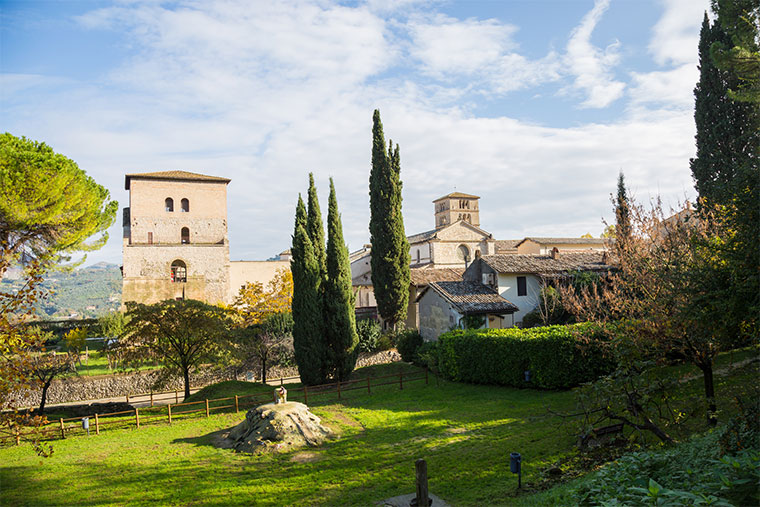Just 25 miles north of Rome, the Sabine Hills are the perfect alternative to other well known regions such as Tuscany. Its quintessentially Italian landscape, made out of rolling hills covered with olive groves and dotted with medieval villages and castles, almost looks like a movie set (except it’s real).
One of the advantages of this region is that it’s still very much unspoilt by mass tourism. You won’t see tour buses nor souvenir shops and if you visit one of the many villages in the area you will find Italian people going about their everyday life, socialising in the piazza, sipping their morning cappuccino or heading off to a nearby field to carry out some farming work.
The Sabine Hills’ history is initially intertwined with the very beginning of Rome. Archaeologists today agree that the foundation of Rome is the result of different populations joining together, each one occupying one of the seven hills. The Sabine population controlling a vast area north of Rome, settled on the Quirinale Hill (where the Italian presidential palace is today). Rome then started expanding towards the Sabine’s territory, conquering their region completely. The Via Salaria (‘Salt Way’) was built to connect the Capital with the Sabine Hills, reaching further to the east coast of Italy, where salt was produced. The whole region then became the main supplier of olive oil and wine for the city of Rome. Today it’s still possible to visit an ancient Roman site called ‘Trebula Mutuesca’ once a major Roman town with its amphitheatre, forum, thermal baths and living quarters.

One of the great sites to see in the Sabine hills is Farfa Monastery. This ancient Benedictine monastery was mentioned for the first time in the 6th Century AD. It’s made out of a series of imposing medieval buildings, including a famous cathedral with its interior covered with fine early renaissance frescoes. There is also a small village here, where the main inhabitants are artists and artisans which display their artwork along the main street and out of ancient medieval shops. Farfa is also home to one of the three traditional artisan fabric makers left in Italy: Scipioni.
Established at the beginning of the 1900’s, Scipioni is the official supplier of fine fabrics for the Presidential House and the Papal Palace in Rome. Many major designers contract Scipioni for their top range products. They still have ancient wooden looms (one of which is from 1895) and turn of the century Jacquard machines operating at the workshop. It’s truly incredible how an individual can keep their family’s traditional business going with passion and dedication still today, in a time of globalisation.
Hiking is one of the many things to do here in the Sabine Hills, walking along trails that are hundreds or even thousands of years old. The natural beauty is everywhere around here and it’s not unusual to cross a crystal clear water stream on an ancient Roman bridge still perfectly standing after 2,000 years. There hills are generally quite gentle in height but you can also find higher mountains toward the east of the region. Here there is Lake Turano, perched amongst the mountains, which offers spectacular views from all angles and its clear water makes it suitable for swimming.
After exploring the region, one of the best ways to reward yourself in the Sabine Hills is to enjoy its food. This region produces one of the most famous extra virgin olive oils of ‘protected designation of origin’ (DOP) in Italy, light yet complex in flavour. The olive tree culture’s glorious history dates back to biblical times, and is closely connected to the environment of the Sabine Region which, over the centuries, has always been shaped by its very presence. The clearest proof of this is represented by the great and imposing olive tree found in Canneto Sabino, a real giant which claims to be ‘The Largest Olive Tree in Europe’ and according to carbon-dating, is around 2000 years old. The ‘Olivone’ (as it’s locally known) is a silent witness of ancient Roman and Sabine history, from imperial times to the decline of the Empire to the Carolingian presence in the territory.
A taste of local pecorino cheese, traditionally made out of sheep’s milk by shepherds in the area, is not to be missed as well as the many traditional local dishes that can be enjoyed at restaurants and trattorie scattered in the countryside.
The Sabine Hills have a lot going for them, with their unspoilt agricultural landscape, rolling hills, olive groves and fruit orchards, not to mention the stunning sunsets, that regularly take your breath away. Its people are welcoming and kind hearted. Its climate is typically mediterranean with long, warm, dry summers, while always being less hot and more breezy than Rome or Florence. For those looking for authentic, idillic rural Italy a stone’s throw from Rome, this is the perfect destination.






























